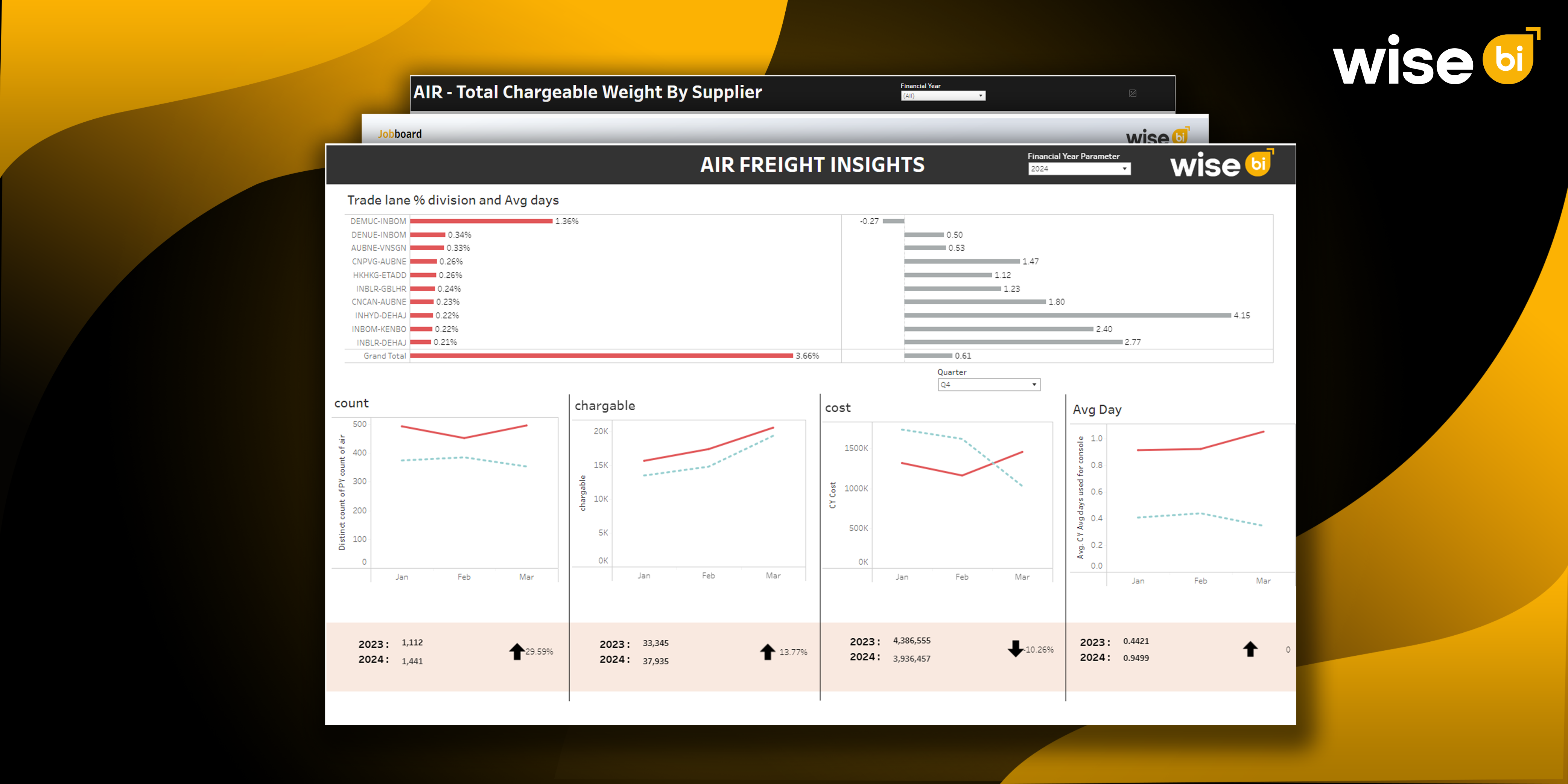Every shipment, delivery, and delay generates data, but without the correct solution, that data remains unusable. Today’s logistics companies are drowning in data but lacking meaningful insight. Business Intelligence (BI) is changing this. Yet, many logistics businesses still don’t fully understand the importance of BI in their operations. By turning raw data into clear visuals and actionable reports, BI helps logistics teams move faster, plan more effectively, and stay ahead of disruptions.
In this article, we’ll explore the key business intelligence trends reshaping the logistics industry, from live dashboards and predictive analytics to AI-powered alerts and role-based insights. These tools go beyond generating reports; they’re fueling smarter, stronger logistics operations.
What is Business Intelligence (BI) in Logistics?
Business Intelligence in logistics refers to the use of software and analytical tools to collect, process, and visualize data from all points throughout the supply chain. These technologies work with basic logistics systems, such as Transport Management Systems (TMS), Warehouse Management Systems (WMS), and Enterprise Resource Planning (ERP) platforms, to provide a consolidated visualization of operations.
Dashboards, reports, and data visualizations give information about key logistical functions such as transportation, warehousing, procurement, finance, and customer service. The goal is not just to evaluate what happened but also to assist in making more informed, proactive actions that improve productivity and reduce risks.
BI gives a variety of insights:
- Operating Insights: Delivery time, shipment volume, route efficiency, and service level compliance metrics.
- Financial Insights: Information about expenses, margins, budget variations, and revenue contribution by service or client.
- Customer Insights: Details about order accuracy, fulfillment speed, satisfaction levels, and problem solutions.
Why is business intelligence (BI) more important than ever in logistics?
Logistics operations now span continents, involve multiple parties, and rely on a diverse set of digital technologies. This connection, while great, adds complexity and risk.
Business Intelligence addresses these difficulties in several important ways:
- Managing Complexity: As supply chains grow more global and linked, BI enables businesses to gain control and clarity by consolidating data into a single, cohesive picture.
- Enabling Real-time Decision-making: Disruptions and delays can happen at any time. BI solutions offer the visibility required to respond fast and effectively.
- Driving Accountability and Performance: Business intelligence (BI) makes it easier to manage KPIs, set benchmarks, and assess results, ensuring that goals are aligned across teams and departments.
- Supporting Strategic Growth: Logistics leaders may identify the potential for innovation, efficiency, and expansion when they have accurate, timely insights.
Key BI Trends Shaping the Future of Logistics
1. Real-Time Visibility with Live Dashboards
One of the most significant shifts in logistics business intelligence is the transition from static, retrospective reporting to real-time, dynamic dashboards. These dashboards are regularly updated with live data sources, providing real-time visibility into critical indicators and operational performance.
This trend allows logistics teams to trace the flow of goods, measure performance against SLAs, and respond to disturbances as they occur. It moves decision-making from reactive to proactive, allowing teams to take corrective action before minor difficulties become big issues.
2. Predictive Analytics for Smarter Planning
Another significant trend is the growing use of predictive analytics in logistics. By examining historical trends, patterns, and performance data, BI tools may accurately estimate future results.
This enables logistics organizations to improve their demand forecasts, capacity management, route planning, and inventory control. Rather than making assumptions, decision-makers now have access to data-driven forecasts that help them allocate resources and mitigate risks more effectively.
3. Embedded AI and Machine Learning in BI Tools
Artificial intelligence (AI) and machine learning (ML) are increasingly being integrated into modern business intelligence (BI) platforms. These technologies improve the capabilities of BI systems by automating data analysis, detecting abnormalities, and recommending the best actions.
Logistics personnel can use built-in artificial intelligence to identify outliers in performance data, forecast difficulties, and obtain advice for future measures. This not only improves the performance of BI tools but also minimizes the manual workload required for data interpretation. The integration of AI and ML accelerates decision-making, reduces errors, and improves strategic planning throughout the logistics chain.
4. Self-Service BI for Non-Technical Logistics Teams
The open access of data through self-service platforms is a significant trend in business intelligence. These solutions are designed to be simple and accessible, allowing non-technical users (such as operations people, sales teams, and customer support representatives) to obtain, evaluate, and act on data without requiring IT assistance.
This move minimizes data bottlenecks, allows for speedier choices, and promotes a more data-driven culture throughout the firm. With self-service BI, every team may track its performance and participate in ongoing improvement efforts.
5. Data Consolidation Across Systems
Many logistics firms deal with fragmented data across numerous systems. This lack of integration makes it difficult to have a comprehensive understanding of performance or the interdependence of functions.
BI is increasingly focusing on breaking down these silos by integrating data from multiple platforms—TMS, WMS, ERP, and CRM—into a single, unified environment. This connection gives cross-functional visibility and improves departmental coordination. Consolidated data enables businesses to uncover the fundamental causes of inefficiencies, optimize end-to-end processes, and make more strategic decisions based on a holistic view of their operations.
6. Customizable Dashboards Tailored to Roles
Another developing trend is the creation of role-specific dashboards. Rather than providing the same view to all users, BI technologies now allow organizations to personalize dashboards to the specific demands and responsibilities of each position.
This guarantees that all stakeholders, regardless of their role, see the most important KPIs and data points. Customizable dashboards enhance the usability of BI technologies, decrease information overload, and let each user focus on what is most important to their role.
The Future is Data-Led: Where Logistics BI is Headed
Looking ahead, the role of business intelligence (BI) in logistics will grow even more automated, intelligent, and strategic.
Key areas for future development include:
- Autonomous Decision-making: BI systems will progress from delivering recommendations to making decisions based on established parameters. This change will improve response times and reduce human error.
- Sustainability and Carbon Tracking: As environmental rules and stakeholder expectations grow, business intelligence (BI) will play an increasingly important role in tracking emissions, measuring sustainability performance, and supporting greener logistical strategies.
- Prescriptive Analytics: The future of business intelligence extends beyond reporting and forecasting to provide prescriptive guidance with clear, actionable recommendations for what actions to take in certain scenarios.
Logistics firms that adopt these innovations will gain a competitive advantage by increasing agility, resilience, and customer happiness.
Conclusion
Business intelligence is changing the way logistics companies work. As supply chains get increasingly complicated, BI dashboards turn raw data into meaningful insights that drive better decision-making. From real-time tracking and predictive analytics to AI-powered tools and customized dashboards, the most recent BI trends enable teams to improve efficiency and service quality.




